| CPC G16H 50/30 (2018.01) [G16H 10/60 (2018.01); G16H 40/20 (2018.01); G16H 40/67 (2018.01)] | 17 Claims |

|
1. A system for generating a second event risk score for an individual, the system comprising:
an electronic medical record store comprising a plurality of medical data elements for the individual, the plurality of medical data elements comprising demographic data, medication data, laboratory data, medical history data, and social determinant data,
wherein the electronic medical record store determines that the individual is currently experiencing an occurrence of a designated first medical event based on information provided to the electronic medical record store, the information being provided by a medical device, the information being collected from the individual by the medical device while being connected to the individual, the designated first medical event being a medical emergency;
wherein in response to determining the occurrence of the designated first medical event for the individual and during the occurrence of the designated first medical event, the electronic medical record store generates and communicates a signal comprising an indication of the occurrence of the designated first medical event; and
a computer server coupled to the electronic medical record store and programmed to, via one or more processors of the computer server:
receive the signal from the electronic medical record store comprising the indication of the occurrence of the designated first medical event for the individual during the occurrence of the designated first medical event;
in response to receiving the signal from the electronic medical record store of the occurrence of the designated first medical event and during the occurrence of the designated first medical event, automatically access the electronic medical record store;
sample, from the plurality of medical data elements in the electronic medical record store, a pre-selected set of medical data elements having a statistical significance of at least P<0.05 for predicting a probability of occurrence of a second event based on the occurrence of the designated first medical event;
generate a second event risk score for the individual by performing a logistical regression analysis of the pre-selected set of medical elements that are sampled from the electronic medical record store, wherein the second event risk score indicates the probability of occurrence of the second event for the individual;
assign the second event risk score to one of a low probability risk category, a moderate probability risk category, or a high probability risk category, wherein the low probability risk category corresponds to the second event risk score in a first range, the moderate probability risk category corresponds to the second event risk score in a second range, and the high probability risk category corresponds to the second event risk score in a third range, wherein a value of the second event risk score in the third range is greater than a value of the second event risk score in the second range, and a value of the second event risk score in the second range is greater than a value of the second event risk score in the first range;
access an electronic medical record (EMR) for the individual;
modify the EMR to include the second event risk score and the one of the low probability risk category, the moderate probability risk category, or the high probability risk category that is assigned, wherein modification of the EMR for the individual includes one or more of modifying an existing data element, adding a new data element, or overriding an existing data element with a new data element within the EMR;
generate a first visually perceptible element that represents the second event risk score and a second visually perceptible element that represents whether the second event risk score is assigned to the low probability category, the moderate probability category, or the high probability category;
deliver the first visually perceptible element and the second visually perceptible element to a browser window to cause display to a user of the first visually perceptible element and the second visually perceptible element for the individual;
generate and communicate a first notification to a medical professional when the second event risk score meets or exceeds a predetermined threshold; and
generate an automated medical management plan for the individual based on the second event risk score,
wherein the individual is treated in accordance with the automated medical management plan.
|